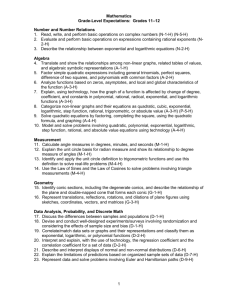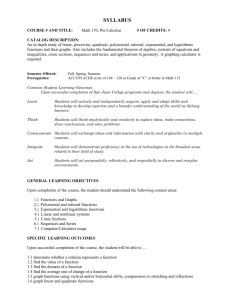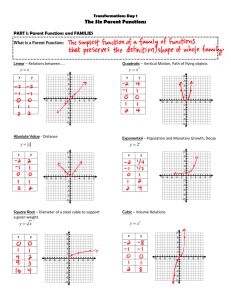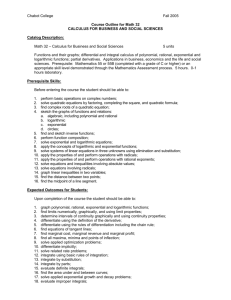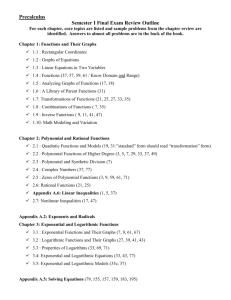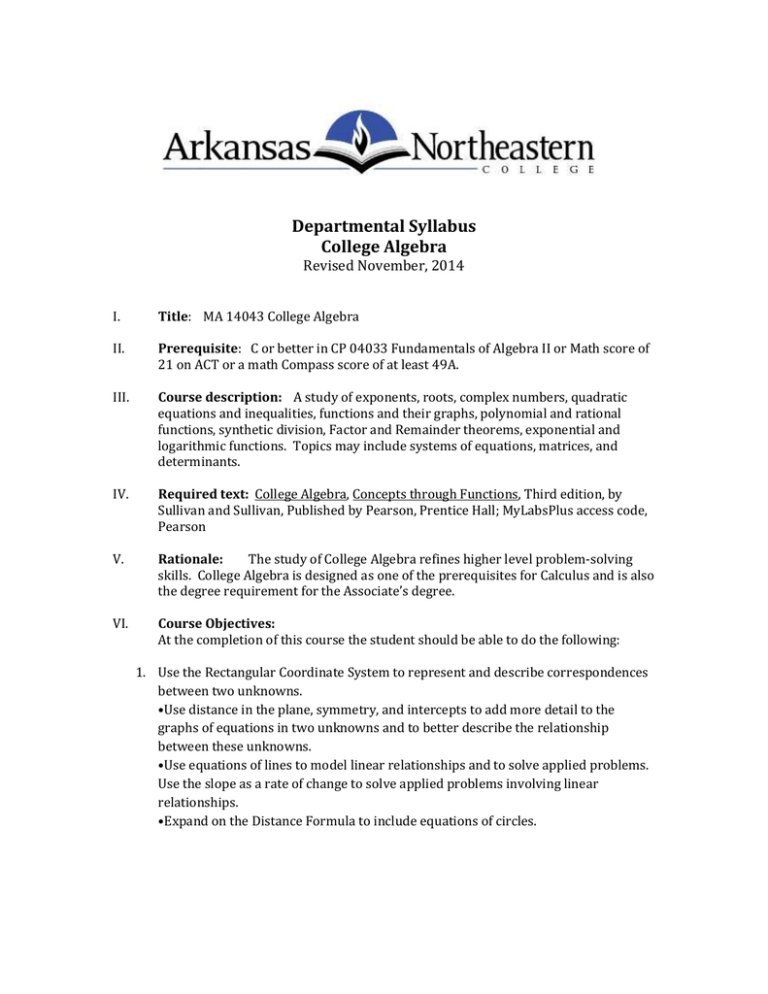
Departmental Syllabus
College Algebra
Revised November, 2014
I.
Title: MA 14043 College Algebra
II.
Prerequisite: C or better in CP 04033 Fundamentals of Algebra II or Math score of
21 on ACT or a math Compass score of at least 49A.
III.
Course description: A study of exponents, roots, complex numbers, quadratic
equations and inequalities, functions and their graphs, polynomial and rational
functions, synthetic division, Factor and Remainder theorems, exponential and
logarithmic functions. Topics may include systems of equations, matrices, and
determinants.
IV.
Required text: College Algebra, Concepts through Functions, Third edition, by
Sullivan and Sullivan, Published by Pearson, Prentice Hall; MyLabsPlus access code,
Pearson
V.
Rationale:
The study of College Algebra refines higher level problem-solving
skills. College Algebra is designed as one of the prerequisites for Calculus and is also
the degree requirement for the Associate’s degree.
VI.
Course Objectives:
At the completion of this course the student should be able to do the following:
1. Use the Rectangular Coordinate System to represent and describe correspondences
between two unknowns.
•Use distance in the plane, symmetry, and intercepts to add more detail to the
graphs of equations in two unknowns and to better describe the relationship
between these unknowns.
•Use equations of lines to model linear relationships and to solve applied problems.
Use the slope as a rate of change to solve applied problems involving linear
relationships.
•Expand on the Distance Formula to include equations of circles.
2. Use the properties and behaviors of algebraic functions to describe or discover
relationships between two unknowns.
•Given a relationship, construct a function that describes that relationship. Use
intercepts, increasing and decreasing, domain and range, and other properties of
functions, to add detail to the relationship and to produce the graph of the function.
•Combine functions to produce new functions and determine the domain and range
of these newly created functions. Transform a basic function to produce a new
function and find its formula.
3. Use the properties and behaviors of linear and quadratic functions to describe the
relationship between two unknowns and to solve problems knowing the
relationship is linear or quadratic.
•Analyze sets of data to determine if it represents a linear relationship.
•Use the properties of a quadratic function such as vertex, intercepts, maximum or
minimum value, increasing or decreasing, etc., to describe a relationship that is
quadratic. Solve problems using these properties, given the description of a
quadratic relationship.
4. Use all the properties of higher-degree polynomial functions and rational functions
to determine behaviors and to produce their graphs.
•Determine the basic behavior of the graph, locate all intercepts and determine the
behavior of the graph at its x-intercepts, and determine where the function is
increasing or decreasing.
•For a rational function, determine the behavior of the graph near any asymptotes
and use this information to produce its graph.
5. Use the properties of exponential and logarithmic functions to describe the
relationships between two unknowns.
•Use exponential functions or logarithmic functions to model exponential growth or
decay and compounded interest.
•Use properties of logarithms to solve logarithmic equations and exponential
equations and determine if the solution is valid.
6. Use the appropriate technology to supplement and enhance conceptual
understanding, visualization, and inquiry.
VII.
Topical/Unit Outline
A.
B.
C.
D.
Functions
Linear and quadratic functions
Polynomial and rational functions
Exponential and logarithmic functions
E.
VIII.
Systems of equations and inequalities
Unit Objectives:
A.
Functions
Rationale: Functions are the basis of the study of algebra, trigonometry,
calculus and concepts in other disciplines.
At the conclusion of this unit, the student should have had the opportunity to
do the following:
1. Given the coordinates of two points in the plane, find the distance
between them and the midpoint of the line segment joining them.
2. Given the distance between two points in the plane, the coordinates of
one point, and one coordinate of the other point, find the value(s) of the
missing coordinate.
3. Given a linear or quadratic equation in two variables, find x-and yintercepts and graph the equation, clearly labeling the intercepts.
4. Given an equation in two variables, test for all three types of symmetry.
5. Given a point on a line and the slope of the line, find the point-slope form
and the slope-intercept form of the equation of that line.
6. Given two points on a line, fine the point-slope form, slope-intercept
form, and general form of the equation of that line.
7. Given an equation of a line, determine the slope of the line parallel to
that line and the slope of the line perpendicular to that line.
8. Given a point on a line and another line parallel or perpendicular to that
line, find the slope-intercept form, point-slope form, and general form of
the equation of that line.
9. Given a point, find an equation of the vertical line through that point and
an equation of the horizontal line through that point.
10. Given a linear relationship described in a word problem, write the
equation relating the two quantities. Interpret the slope by stating the
units on the slope and how it applies in the context of the word problem.
11. Given the radius of a circle and a point on that circle, write the Standard
Form of the equation of that circle.
12. Given the radius of a circle and its center, graph the circle.
13. Given the General Form of the equation of a circle, complete the squares
to find the Standard Form of the equation of the circle, then find the
center and radius of the circle.
14. Given a relation as a mapping, set of ordered pairs, a graph, or an
equation, determine if the relation is a function.
15. Given a function defined using function notation, evaluate the function
for constant and variable values.
16. Find the domain of a linear, quadratic, rational, or square root function.
17. Given two functions, form the sum, difference, product, and quotient of
the two functions and find their domains.
18. Given a function and the definition of the difference quotient, find the
value of the difference quotient. Simplify the difference quotient so that
the denominator cancels.
19. Given the graph of a function, find its x and y intercepts, domain, range,
zeros, symmetry, function values given an x-value, and x-values given a
function value.
20. Given the formula for a function, determine if it is even or odd by finding
f(-x).
21. Given the graph of a function or the formula for a function, find intervals
on which a function is increasing, decreasing or constant.
22. Given the function definition, graph a piecewise-defined function, clearly
labeling all intercepts and open circles. List the range of this function
using its graph.
23. Given the graph of a basic function, graph the function that has been
shifted vertically and/or horizontally or reflected about the x or y axis.
24. Construct a function using geometric or other relationships given in a
word problem.
Chapters F, sections 1 through 4 and Chapter 1, sections 1
through 5
B.
Linear and Quadratic Functions
Rationale: We begin our study of functions with first and second degree
polynomial functions. These are used to model many physical
applications in science, business, and other disciplines.
At the conclusion of this unit, the student should have had the opportunity to
do the following:
1. Given a linear function, find its zero, y intercept, and slope, and use this
information to graph the function.
2. Given a linear function, find its average rate of change (slope).
3. Given a verbal description of a linear relationship, set up the linear
function and use it to solve the applications problem.
4. Find the two zeros of a quadratic function by factoring, using the square
root method, completing the square, and using the quadratic formula.
5. Given any combination of linear and quadratic functions, analytically
find the point(s) of intersection of the two graphs.
6. Solve equations that are in quadratic form by factoring or using the
quadratic formula.
7. Given a quadratic function, find the coordinates of its vertex, x-intercepts
(if any), its y-intercept, and then graph it using this information.
8. Given a quadratic function, determine if it has a maximum or minimum
value and then find it (vertex).
9. Given the description of a quadratic relationship in a word problem, find
the function describing it and then use this function to solve
optimization problems (vertex) or other applications problems of
quadratic functions.
10. Find the complex zeros of a quadratic function by using the quadratic
formula.
Chapter 2, Sections 1 through 8
C.
Polynomial and Rational Functions.
Rationale: The concepts learned in the study of linear and quadratic
functions are broadened to include all polynomial functions. Rational
functions are then formed by dividing polynomial functions.
At the conclusion of this unit, the student should have had the opportunity to
do the following:
1. Given a polynomial function of degree three or higher in factored form,
find the real zeros and their multiplicities, y-intercept, basic shape of the
graph and use all of this information to sketch the graph of the
polynomial function.
2. Given a rational function, find its domain.
3. Given a rational function having one or two vertical asymptotes, find the
location of these vertical asymptotes, any horizontal asymptotes, x and y
intercepts, and use this information to graph the rational function.
4. Given a written description of an inverse or joint variation relationship,
construct a model and use this model to solve an application problem.
5. Solve polynomial inequalities of degree two or higher and rational
inequalities and write the solutions using interval notation.
6. Given a polynomial function of degree three or higher and a linear
divisor, use the Remainder Theorem to find the remainder of the
division.
7. Given a polynomial function of degree three or higher, find all the zeros
(real or complex) of a polynomial function by using the Rational Zeros
Theorem and synthetic division and the quadratic formula (if needed).
8. After finding all the zeros of a polynomial function, use the Factor
Theorem to write the function in factored form.
9. Given a polynomial function and an interval in its domain, use the
Intermediate Value Theorem to determine if there is at least one real
zero in that interval.
Chapter 3, Sections 1 through 6.
D.
Exponential and Logarithmic Functions
Rationale: Exponential and Logarithmic functions are needed to model
growth and decay applications problems and compounded interest
applications. They are also needed for any additional studies in
probability and statistics, chemistry, and other disciplines.
At the conclusion of this unit, the student should have had the opportunity to
do the following:
1. Given two algebraic functions, find the rule and domain for the
composite function.
2. Given a function as a mapping, set of ordered pairs, or a graph,
determine whether the function is one-to-one.
3. Given a polynomial or rational function that is one-to-one, find its
inverse function.
4. Given a one-to-one function, find its domain and then find its range by
finding the domain of the inverse function.
5. Given a function and its inverse, verify that they are inverses by finding
their composition.
6. Evaluate exponential functions using a calculator.
7. Graph an exponential function having a base larger than one and also
graph an exponential function have a base between zero and one.
8. Graph and evaluate (using a calculator) the Natural Exponential
Function.
9. Solve exponential equations by applying the Laws of Exponents and
using the property, “If 𝑎𝑢 = 𝑎𝑣 𝑡ℎ𝑒𝑛 𝑢 = 𝑣".
10. Given the exponential function to describe a relationship, use this
function and a calculator to solve an applied problem.
11. Using the definition of a logarithm, change exponential expressions to
logarithmic expressions and vice versa.
12. Evaluate logarithmic expressions by rewriting them in exponential form
and solving for the unknown exponent.
13. Given a logarithmic function having a base larger than one or a base
between zero and one, graph this function, and compare it to the graph
of the exponential function of the same base.
14. Given a logarithmic function with a polynomial or rational argument,
find its domain.
15. Evaluate natural logarithms, both with a calculator and without a
calculator (if possible).
16. Solve logarithmic equations by rewriting the equation in the exponential
form and solving for the unknown.
17. Use the Properties of Logarithms to rewrite a log expression in terms of
simpler logarithms.
18. Use Properties of Logarithms to write an expression as a single
logarithm with a coefficient of one.
19. Solve logarithmic equations by using the appropriate Properties of Logs
and the property, “If log 𝑏 𝑥 = log 𝑏 𝑦 𝑡ℎ𝑒𝑛 𝑥 = 𝑦.”
20. Solve exponential equations where the bases are not the same by taking
the log of both sides and solving for the unknown. The exact value and
the approximate value of the solutions should be found.
21. Given the models for compounded interest and continually compounded
interest, solve applications problems to find the principal needed to
produce a given result, or to find the time needed to produce a given
result.
22. Given written information and the model for exponential growth or
decay, find the growth or decay constant and the function describing the
situation. Solve, then, applications problems involving this exponential
growth and decay function.
Chapter 4, Sections 1 through 8
E.
Systems of Equations and Inequalities
Rationale: Systems of equations and matrices are used to solve applied
problems with several unknowns. This is also the basis of additional
studies in linear algebra.
At the conclusion of this unit, the student should have had the opportunity to
do the following:
1.
2.
3.
4.
5.
Solve systems of linear equations by substitution and elimination.
Solve a system of linear equations using matrices.
Evaluate 2 by 2 and 3 by 3 determinants.
Find the sum and difference of two matrices.
Find the scalar multiple of a matrix, the product of two matrices, and the
inverse of a matrix.
Chapter 6, Sections 1 through 4
IX. Course Policies: Grades
Grades of "Incomplete":
The current College policy concerning incomplete grades will be followed in this
course. Incomplete grades are given only in situations where unexpected
emergencies prevent a student from completing the course and the remaining work
can be completed the next semester. Your instructor is the final authority on
whether you qualify for an incomplete. Incomplete work must be finished by
midterm of the subsequent semester or the “I” will automatically be recorded as an
“F” on your transcript.
X. Email
Arkansas Northeastern College has partnered with Google to host email addresses
for ANC students. myANCmail accounts are created for each student enrolled in the
current semester and is the email address your instructor will use to communicate
with you. Access your email account by going to
http://mail.google.com/a/smail.anc.edu and using your first and last names,
separated by a period for your username. Your default password is the last six
digits of your Student ID. If you cannot access your student email, contact the MITS
department at 762-1020 ext 1150 or ext 1207 or send an email to
ANChelp@smail.anc.edu.
Correspondence from the instructor to the students will occur through the smail
accounts and through postings on the main page of the course on myANC. The
instructor will check email several times a day and at least once on the weekends.
Internet: This course has a web component on myANC. Homework must be done
through MyMathLab and the MyMathLab average must be used in calculating the
final grade. Students can access average grades on MyMathLab by looking at the
grade in that gradebook. The average grade for the class will be in the gradebook in
myANC.
Classroom Devices: Scientific calculators should be brought to each class. With the
permission of the instructor, a student may tape the lectures.
Computer Labs: In addition to general-purpose
classrooms, a number of computer laboratories are
provided for
instructional and student use. These networked
laboratories are state-of-the-art and fully equipped
with
computers, printers, Internet connections and the
latest software. The labs are open to students
enrolled in one or more credit hours at the College.
Technology Support: A lab assistant is generally present in the computer lab in
B202 for assistance in using the College computers. These assistants cannot help
you with course assignments; specific questions regarding the technology
requirements for each course should be directed to the instructor of the course.
Problems with myANC or College email accounts should be addressed by email to
ANCHelp@smail.anc.edu.
XI.
Course Policies: Student Expectations
Disability Access: Arkansas Northeastern College is committed to providing
reasonable accommodations for all persons with disabilities. This First Day Handout
is available in alternate formats upon request. Students with disabilities who need
accommodations in this course must contact the instructor at the beginning of the
semester to discuss needed accommodations. No accommodations will be provided
until the student has met with the instructor to request accommodations. Students
who need accommodations must be registered with Dr. Blanche Sanders or Suzanne
Robinson at the Learning Assistance Center, Room L104.
Professionalism Policy: When using email and discussion forums, remember that
they are an all-text medium. Social cues that help bring meaning to normal
conversations such as tone of voice, facial expressions and body language are not
present. Clear and careful writing is especially important. Be careful with wit and
humor. Without face-to-face communications, with and humor maybe viewed as
criticism and disrespect.
Academic Conduct Policy:
Academic dishonesty in any form will not be tolerated. If you are uncertain as to
what constitutes academic dishonesty, please consult ANC’s Student Handbook
(http://www.anc.edu/docs/anc_handbook.pdf) for further details. Students are
expected to do their own work. Plagiarism, using the words of others without
express permission or proper citation, will not be tolerated. Any cheating (giving or
receiving) or other dishonest activity will, at a minimum, result in a zero on that test
or assignment and may be referred, at the discretion of the instructor, to the
Department Chair and/or Vice President of Instruction for further action.
See the Academic Integrity Policy.
Learning Assistance Center: The Learning Assistance Center (LAC) is a free
resource for ANC students. The LAC provides drop-in assistance, computer tutorials
and audio/visual aids to students who need help in academic areas. Learning labs
offer individualized instruction in the areas of mathematics, reading, writing,
vocabulary development and college study methods. Tutorial services are available
on an individual basis for those having difficulty with instructional materials. The
LAC also maintains a shelf of free materials addressing specific problems, such as
procedures for writing essays and term papers, punctuation reviews, and other
useful materials. For more information, visit the LAC website at
http://www.anc.edu/LAC or stop by room L104 in the Adams/Vines Library
Complex.
Other Student Support Services: Many departments are ready to assist you reach
your educational goals. Be sure to check with your advisor; the Learning Assistance
Center, Room L104; Student Support Services, Room S145; and Student Success,
Room L101 to find the right type of support for you.
XII.
Evaluation and Assessment Methods.
A.
Each student will be post-tested using the computerized Compass exam. A
student should not receive a grade in the course without completing the
Compass exam.
B.
Students should not be allowed to use books or notes on any unit exams or
final exam in College Algebra.
C.
The final exam will be a common, departmental final exam. The final exam
will be comprehensive and the grade on the final exam must be used in the
calculation of the course grade.
D.
Other course assessments will also be used and will be supplied by the
Mathematics Department.
E.
MyMathLab is a computerized homework program and must be used by all
instructors. The student’s score in MyMathLab must be used in the
calculation of the final grade.


